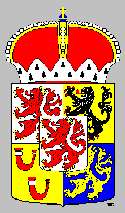Limburg (Netherlands)
|
|
Limburg is the southern-most of the twelve provinces of the Netherlands, located in the south-east of the country. It is bordered by Belgium in the west, Germany in the east, and the province of North Brabant in the north.
| |||
| Missing image Limburg-Position.png Image:Limburg-Position.png | |||
| Capital | Maastricht | ||
| Queen's Commissioner (also called a Governor in Limburg) | Leon Frissen | ||
| Area - Total - % water | 11th 2,211.70 km² ?% | ||
| Population - Total (2002) - Density | 5th 1,142,737 471/km² | ||
| Inclusion | 1839 | ||
| Anthem | In 't bronsgroen eikenhout Listen (http://www.limburg.nl/upload/algemeen/Waar%20in%20%27t%20bronsgroen%20eikenhout.mp3) | ||
| Contents |
History
Politically, Limburg used to look like a patch quilt with many counties and other sorts of properties carving up the land. A result that can still be noticed today is that the inhabitants of each municipality speak their own, distinct language.
In 1814/1815, with the formation of the new Kingdom of the Netherlands, one of the new provinces was to receive the name Maastricht, after its capital. King William, who did not want the name Limburg to be lost, insisted that the name be changed to Limburg. As such, the name of the new province derived from the old duchy of Limburg that had existed until 1648 within the triangle Maastricht - Liège - Aachen.
When the Netherlands and Belgium separated in 1830, there was support for adding Limburg to Belgium, but in the end (1839) the province was divided in two, with the eastern part going to the Netherlands and the western part to Belgium. Dutch Limburg was from that moment on, as the Duchy Limburg, also part of the German Confederation.
The province used the title 'duchy' until 1906. Another idiosyncrasy survives today: the head of the province, referred to as the "Queen's Commissioner" in other provinces, is addressed as "Governor" in Limburg.
In December 1991 the European Community (nowadays European Union) held a summit in Maastricht. At that summit, the so-called Maastricht treaty was signed by the European Community member states. The original name for that treaty was "Treaty of the European Union". With that treaty, the European Union came into existence for the first time. More info at the BBC website [1] (http://news.bbc.co.uk/1/hi/in_depth/europe/euro-glossary/1216944.stm).
In 't Bronsgroen Eikenhout is the 'official' anthem of the region of Limburg, both in Belgium and the Netherlands.
Languages
Limburg has its own language, called Limburgish (Dutch: Limburgs). This is, since 1997, an official regional language, and as such receives moderate protection under Chapter 2 of the European Charter for Regional or Minority Languages. Limburgish is spoken by an estimated 1.6 million people in both Belgian and Dutch Limburg. There are many different dialects in the Limburgisch language. Almost every town of village has its own slightly different dialect. Dialects more toward the German border (near Aachen for instance) have a more German influence, while dialects spoken in the Meuse (Dutch: Maas) valley have a more French tone to them. Some towns and municipalities even have different dialects within themselves, most often represented by how they say "hello".
Preservation of the local dialects is thanks to the almost rabid efforts of the native speakers. For example, people from opposite sides of the Meuse within the same city of Maastricht will sometimes feign ignorance of one another's dialect; even going so far as pretending not to know Dutch, which is the official language of the province and the language used to teach in schools. This is a rivalry based not on history, but on a stubborn determination not to allow their dialects to become moribund and eventually disappear.
Besides the Limburgish language, all people speak Dutch. In areas near the German border, most people also speak German. As with all of the Netherlands, the majority of Limburgers also speak English with varying degrees of fluency.
Politics
The provincial council (Provinciale Staten) has 63 seats, and is headed by the Queen's Commissioner, currently Leon Frissen. While the provincial council is elected by the inhabitants, the Queen's Commissioner (Governor) is appointed by the Queen and the cabinet of the Netherlands. The Christian CDA is currently the largest party in the council.
The daily affairs of the province are taken care of by the Gedeputeerde Staten, which are also headed by the Queen's Commissioner (Governor); its members (gedeputeerden) can be compared with ministers.
Municipalities
Geography
The south of the province is remarkable when compared to the rest of the country, as it is one of the few regions that has hills. The highest point in the Netherlands, the Vaalserberg, is situated in Limburg.
Limburg's surface consists mainly of sand. The most important river is the Meuse, that passes through the entire length of the province from South to North.
Major cities are the provincial capital Maastricht in the south, the urban agglomerations of Sittard-Geleen and Heerlen-Kerkrade, Roermond and Venlo.
Economy
In the past peat, gravel and coal were mined in Limburg. The state-owned corporation that used to mine in Limburg, DSM, is currently a major chemical company, still operating in Limburg. Automotive industry (Born) and production of copiers and printers (Océ in Venlo) are also present.
See also
External Links
- Official Website (in Dutch) (http://www.limburg.nl)
- province map showing subdivision in municipalities, link for each municipality to basic data page (http://www.sdu.nl/staatscourant/gemeentes/gemprovin.htm#L)
- the Maastricht Treaty (http://news.bbc.co.uk/1/hi/in_depth/europe/euro-glossary/1216944.stm)
Template:Footer Provinces of the Netherlandsde:Limburg (Niederlande) eo:Limburg (Nederlando) fr:Limbourg (Pays-Bas) fy:Limburch (Nederlân) id:Limburg (Belanda) it:Limburgo (Paesi Bassi) li:Hollesj Lèmburg nl:Nederlands-Limburg sv:Limburg (Nederländerna)


